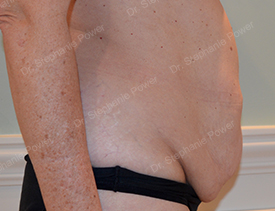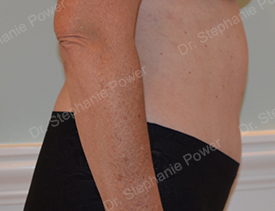Tummy Tuck at Power Plastic Surgery
Having a toned stomach is one of the most common patient requests we receive at Power Plastic Surgery. The abdomen is one of the first locations to show signs of weight gain for many individuals. Excess skin and fatty tissue often develop in the abdominal area due to the effects of aging, pregnancies, and weight gain. Skin gradually loses elasticity and is stretched beyond its ability to contract following weight loss.
However, a tummy tuck surgery can address any and all of these concerns, improving the contour of the stomach, firmness of the muscles, and tightness of skin.
Tummy Tuck Symptoms
Tummy tuck patients often present with abdominal wall weakness in addition to a central bulge, due to separation between the abdominal muscles following pregnancies or significant weight fluctuation. This muscle gap is often more pronounced following multiple pregnancies, multiple births, and large birth weight babies. Candidates for tummy tuck surgery also commonly develop stretch marks.
How is a Tummy Tuck Performed?
A tummy tuck surgical procedure is performed under general anesthesia and patients are generally admitted to the overnight facility in Toronto until the following morning for observation and pain control.
Dr. Power, a Royal College-certified plastic surgeon, creates an incision on the lower abdomen, from hip to hip, and a small incision around the umbilicus (belly button). Excess skin and subcutaneous fat tissue is removed and the abdominal muscles can be repaired and tightened in the midline.
The incisions are closed in a way that any permanent scarring can be concealed by underwear and swimwear.
Preparing for Abdominoplasty
During initial consultation about a tummy tuck, Dr. Power will gather your detailed medical history and perform an examination to rule out contraindications for tummy tuck surgery and to determine if any pre-existing conditions may require optimization prior to surgery.
You may wonder, is a tummy tuck painful? During your consultation, we will go over the ins and outs of the procedure, including the anesthesia used, recovery after surgery, and proper aftercare.
Tummy tuck candidates must quit smoking at least 4 weeks before and after the operation to lower risk of complications. Smoking is associated with higher incidence of infection and partial abdominal flap necrosis (skin death), which may result in a large region of the stomach to experience delayed wound healing.
Tummy Tuck vs. Liposuction
Although tummy tuck can dramatically improve the appearance of the abdomen by tightening abdominal wall muscles and removing excess fat and skin, it is a major cosmetic surgery. Patients often inquire regarding a less invasive option—for example, liposuction—to address excess abdominal skin and fatty tissue.
Unfortunately liposuction or other non-surgical plastic surgery procedures are typically not an option for most patients who have had pregnancies or significant weight fluctuation, given that the skin has lost elasticity. In these cases, simply suctioning away excess fat wouldn’t help, as skin would not contract adequately afterwards. This would increase the amount of loose skin and negatively affect the appearance of the stomach.
Who is a Suitable Candidate for a Tummy Tuck (Abdominoplasty)?
Patients considering a tummy tuck are generally interested in flattening and firming their abdominal contour. Anyone who struggles with stretch marks, muscle laxity, loose skin, or persistent fat that doesn’t respond to diet and exercise may be a good candidate for tummy tuck procedures. In addition, a candidate for any type of elective plastic surgery procedure should have well-defined concerns about their appearance and achievable goals through plastic surgery procedures.
Body weight, weight history, and pregnancy history are also important considerations for Toronto tummy tuck surgery. The recommended body mass index (BMI) for patients considering abdominoplasty is less than 30–ideally closer to or less than 25–and stable weight for at least 6 months pre-operatively.
It is recommended for tummy tuck candidates to have completed pregnancies before proceeding with tummy tuck surgery. Although it is possible to carry a full-term pregnancy following abdominoplasty, this would place significant tension on the rectus plication (muscle repair site) and further stretch abdominal soft tissues. Revision procedure may be required following significant weight loss or pregnancy after abdominoplasty has been performed.
Candidates for a tummy tuck should also keep in mind that if significant weight loss occurs after a tummy tuck, it may result in additional excess skin and soft tissue which can make tummy tuck results less predictable.
Causes of Common Abdominoplasty Candidate Conditions
People who have been pregnant in the past or have experienced significant weight fluctuation often develop excess subcutaneous tissue (whether fat or glandular tissue), decreased skin elasticity, and excess skin that results in skin folds and abdominal striae (stretch marks).
In addition to these skin and soft tissue changes, rectus diastasis (gapping between the rectus abdominus muscles) commonly develops in patients with a history of pregnancy or severe weight loss that may reduce core strength and lead to abdominal bulging. Abdominoplasty, or tummy tuck surgery, addresses these concerns by resecting excess skin and subcutaneous tissue from the abdomen as well as tightening and reinforcing the rectus muscles in the midline.
What are the Different Types of Tummy Tuck (Abdominoplasty) Surgery?
The three most common types are the standard tummy tuck, a mini-tummy tuck, and a circumferential tummy tuck. The extent of abdominal skin laxity will be carefully assessed during your clinical examination with Dr. Power to determine the most appropriate technique to achieve your goals.
STANDARD TUMMY TUCK
A standard tummy tuck is the most common technique performed to address skin redundancy of both the anterior abdomen—including the upper abdomen—as well as rectus diastasis. It includes making an incision along the lower abdomen from hip to hip, as well as a small additional incision around the belly button.
MINI TUMMY TUCK
Patients in Toronto with a lesser degree of excess or loose skin and subcutaneous tissue limited to the lower abdomen may be candidates for a mini tummy tuck. This procedure is less invasive than a regular tummy tuck procedure and does not alter the abdomen above the umbilicus (belly button). Additionally, there is no scar around the umbilicus.
A mini tummy tuck may be recommended for patients whose loose skin and excess fat is limited to the region below the navel.
CIRCUMFERENTIAL TUMMY TUCK
If skin laxity extends to your back, which is common in patients following bariatric surgery and significant weight loss, board-certified plastic surgeon Dr. Power may recommend a circumferential tummy tuck. The excision procedure is extended around the body onto the lower back to address excess skin and fat in this region, which improves overall contour.
Toronto Tummy Tuck Recovery and Results
A tummy tuck procedure is highly effective at flattening and firming your abdominal muscles, removing excess skin and fat tissue, and often, repairing rectus diastasis (gapping between the rectus—“six-pack”—muscles) that commonly results after pregnancy or significant fluctuations in body weight.
Here’s what tummy tuck patients can expect following surgery:
- Patients are generally admitted overnight following surgery for monitoring in our Toronto recovery suite.
- You will be closely monitored to ensure that there is no significant bleeding and that you are tolerating oral pain medication and are able to walk short distances prior to discharge home.
- Two drains are typically placed to lower the risk of fluid accumulation under the abdominal flap, which could lead to wound healing complications or infection.
- You will be instructed on how to care for and measure drain output at home. Dr. Power generally removes the drains within the first week of surgery once output has decreased to an appropriate amount.
- Dr. Power recommends patients to begin showering daily starting the day after the procedure and to change the gauze underneath the abdominal binder.
- You will need to wear your compression garment for 6 weeks following surgery. It provides additional support for the muscle repair during early healing and lowers the risk of fluid accumulation.
- Small pieces of surgical tape will be placed over the incisions for the first one to two weeks after tummy tuck surgery.
- A tummy tuck scar will heal in the incision area after tummy tuck surgery.
What is the Anticipated Recovery After Tummy Tuck (Abdominoplasty)?
- Patients are generally able to resume office work (paperwork equivalent) within 1-2 weeks following a tummy tuck.
- Pain medication is usually required for the first few days following surgery.
- Dr. Power also prescribes a short course of antibiotics to lower risk of infection while the drains are in place.
- Specific recommendations for activity modifications will be made for you based on your job activity level and requirements.
- Patients may resume exercising 6 weeks post-operatively, which ensures that the muscle repair site has healed well by this stage.
How Much Should I Weigh Before Considering Tummy Tuck Surgery?
It is recommended for patients to achieve a healthy body mass index (BMI) prior to surgery. This will lower the risk of surgical and anesthetic complications and also result in a better aesthetic outcome. Ideally a BMI less than 25 is recommended pre-operatively.
Tummy tucks are not a weight loss surgery. They are performed to improve abdominal contour in people who are at or close to their ideal weight. At higher body mass indexes (BMIs), patients often present with increased fatty tissue within the abdomen, called visceral fat, that is deep within the abdomen. It surrounds body organs and is not addressed by surgical tummy tuck procedures. It is also the type of fat linked with increased risk of cardiovascular disease, diabetes, and other systemic illnesses. If abdominoplasty is performed on a patient with significant visceral fat, the abdominal contour may still be rotund after surgery.
Should I Have a Mini or Full Tummy Tuck?
Few patients are candidates for a mini tummy tuck if rectus diastasis (muscle separation) is present. A mini tummy tuck may be an option for a slender patient with very little excess skin and soft tissue that is limited to the lower abdomen only. A mini tummy tuck does not address the abdomen above the level of the belly button.
Are the Effects of Tummy Tuck Long-Lasting?
As many board-certified plastic surgeons agree, a tummy tuck can provide body contour benefits for many years, as long as one maintains a healthy diet and exercise regimen post-operatively..
What Are The Potential Complications of a Tummy Tuck (Abdominoplasty)?
When performed by board-qualified plastic surgeons, tummy tucks are highly successful and low-risk procedure. However, because tummy tuck procedures are invasive surgeries, there are always risks involved, both local and systemic. Dr. Power will explain your specific risks and risk factors associated with your abdominoplasty during your consultation.
Local complications
- Bleeding
- Hematoma (collection of blood or ongoing bleeding deep to the abdominal flap)
- Seroma (fluid collection)
- Infection
- Delayed wound healing
- Dehiscence (wound separation)
- Partial skin flap or umbilical necrosis
- Failure of the plication sutures
- Hypertrophic or widened scarring
- Overcorrection
- Undercorrection
- Asymmetry
- Systemic complications
- Thromboembolism – deep venous thrombosis (DVT)
- Pulmonary embolism (PE)
- Potential complications related to general anesthetic
How Can I Reduce Tummy Tuck Risks and Complications?
Dr. Power of Power Plastic Surgery takes many precautions to lower risk of complications associated with tummy tuck and mini tummy tuck procedures. Patients are evaluated based on risk factors for thromboembolism (blood clot) development. For patients at low risk, thromboembolic deterrent (TED) stockings and sequential compression devices (SCDs) are applied before general anesthesia is introduced for the procedure. SCDs intermittently tighten around the lower part of the body throughout surgery and during early recovery until patients are able to move around well.
Through a pumping mechanism, SCDs increase blood flow to the heart and decrease blood pooling in the lower extremities, which lowers the risk of deep venous thrombosis (DVT) formation. Patients are also recommended to begin walking shortly after abdominoplasty procedures to encourage normal circulation. Those at higher risk for thromboembolic events may require anticoagulant (blood thinners), which can lower the patient’s risk of developing DVT or PE by decreasing blood viscosity.
Despite the potential complications of a tummy tuck, Power Plastic Surgery completes rigorous patient selection procedures and optimizes operations accordingly, even consulting with other medical services as needed, to make a tummy tuck Toronto a well-tolerated surgery with high patient satisfaction.
Tummy Tuck Procedure in Toronto
For medical excellence and naturally beautiful results from a tummy tuck surgery, or abdominoplasty, Power Plastic Surgery may be the right choice for you. As a board-certified plastic surgeon who has performed hundreds of successful procedures for Toronto area patients, Dr. Stephanie Power is ready to hear about your goals for abdominal rejuvenation. Call Power Plastic Surgery at 416-962-1010 or request your consultation online to learn more how a tummy tuck procedure can benefit you.




"I think the best results are natural-looking. Refreshed and reflected by a patient’s self-confidence."
- DR. STEPHANIE POWER